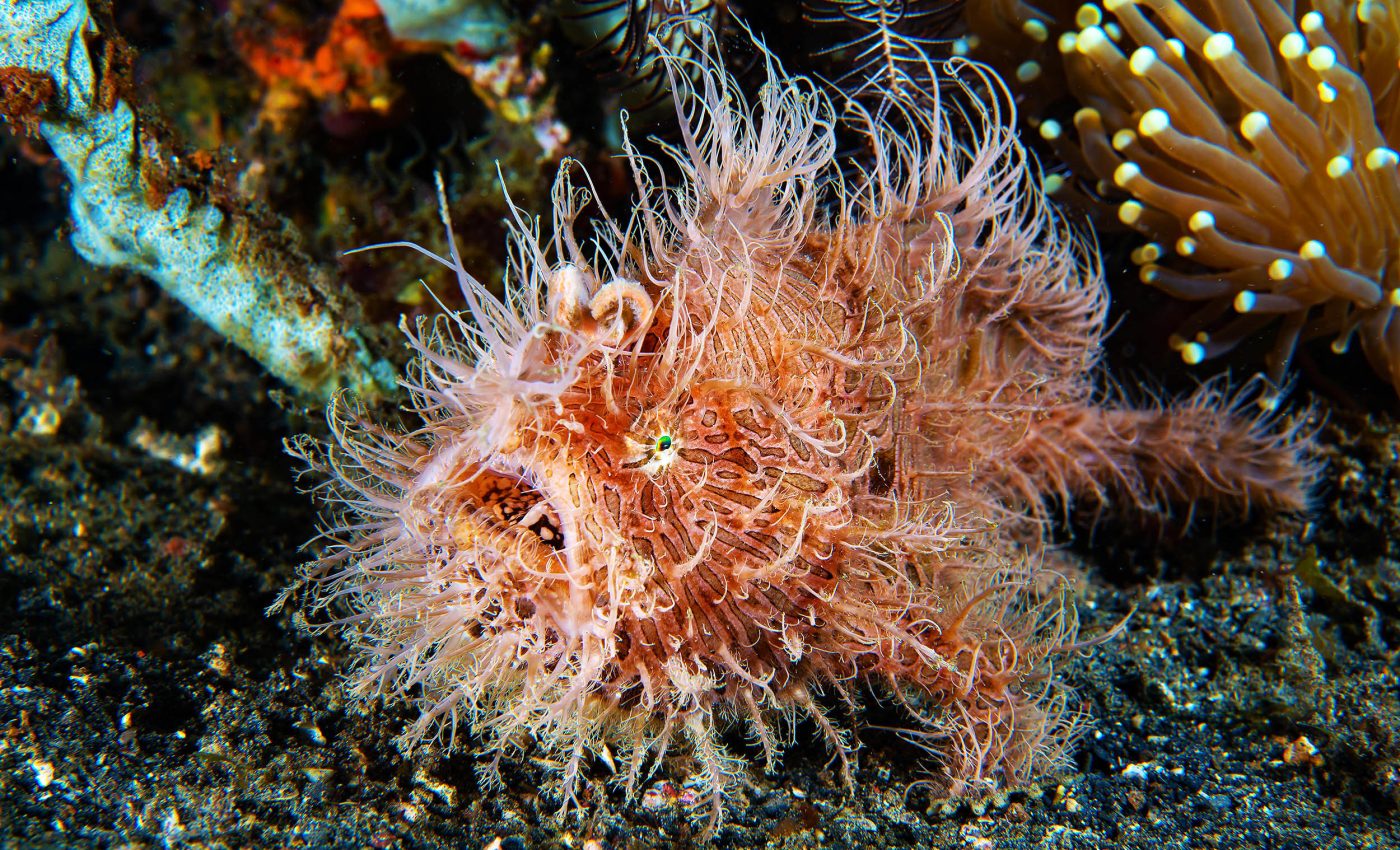
Strangest fish in the ocean walks on the seafloor, changes colors, and uses a fishing lure
The hairy frogfish looks more like a tuft of drifting seaweed than a hunter. Yet beneath the mop of filaments sits an anglerfish that can inhale prey faster than most cameras can blink.
Marine ecologist Dr. Maarten De Brauwer of Curtin University first noticed that the fish’s lure shines neon orange under blue light, while the rest of the body stays dull.
His team’s 2016 field survey on Philippine reefs linked that glow to free‑swimming worms that share the same color and size.
Hairy frogfish hides by copying reef textures
The hairy frogfish belongs to the anglerfish family, but instead of lurking in the deep it prowls coral rubble in tropical shallows.
A coat of branching spinules lets it copy the texture of algae, sponge, or coral until the head seems to vanish into the seafloor.
Individuals can swap pattern and shade within weeks, shifting from lemon yellow to mottled black as sediment, light, and growth change around them.
That rapid makeover is a textbook example of Batesian mimicry, a tactic where harmless looks discourage predators while inviting unsuspecting prey.
Sight alone does not give the trick away, because even the fish’s eyes carry radiating stripes that obscure the pupil.
Only the stubby “arm” formed by the first dorsal spine, called the illicium, rises above the camouflage like a tiny fishing pole.
How the glowing lure helps the hairy frogfish
“These observations indicate a novel function, prey capture, for biofluorescence in coral reef fishes,” wrote De Brauwer.
Under daylight the illicium ends in a dull worm‑shaped tassel, but blue‑filtered lamps reveal intense biofluorescence that converts blue light to orange.
The idea fits a wider pattern, because a survey of 180 fish species found glowing pigments clustered in cryptic reef lineages.
American Museum of Natural History ichthyologist Dr. John Sparks noted that “biofluorescence is especially common and morphologically variable in cryptically patterned coral‑reef lineages,” hinting at communication or hunting value.
By matching the fluorescent worms that drift over sandy bottoms at night, the lure likely acts as a living decoy.
The fish twitches the tip in arcs and pulses that copy the jellied plankton’s swim, drawing curious gobies and cardinalfish within lunging range.
Fastest strikes on record
Once a victim lines up, the mouth opens twelve times wider than its resting size, pulling in water and prey through rapid suction feeding.
High‑speed videos have timed the attack at just six milliseconds, making the frogfish one of the quickest predators recorded.
That burst happens because elastic ligaments around the jaw store energy while the fish crouches. Releasing the latch snaps the head forward, creating a pressure wave that drags prey inward before the target knows it moved.
The stomach then stretches like a balloon, letting a four‑inch frogfish swallow a meal almost twice its own length. Mouth, stomach, and even gill covers reset within minutes, ready for the next ambush without swimming far.
Hairy frogfish lives without swimming
Frogfish seldom swim, preferring a slow shuffle powered by limb‑like pectoral and pelvic fins. The gait looks clumsy, yet it lets the animal creep through branching corals or over sponges without stirring mud.
FishBase records show the species from New Jersey to Brazil and across the Indo‑Pacific, at depths ranging from tide pools to 720 feet.
Most adults settle below 100 feet where wave surge is gentle, but juveniles often lurk among shore grass beds that teem with shrimp.
Males change color during courtship, trailing females to the surface where a buoyant ribbon of up to 288,000 eggs drifts free. Larvae hatch in open water and later drop to the bottom, beginning the camouflage dance anew.
What the findings mean
“Aggressive mimicry allows a predator to masquerade as something harmless to approach prey,” wrote marine zoologist John E. Randall. Aggressive mimicry, where a predator disguises itself as the prey’s food, shows up in a handful of reef hunters.
The fluorescent lure adds a light signal to that illusion, effective only for animals with visual pigments tuned to blue and green. Future lab tests will measure how often fish reject non‑fluorescent lures compared with glowing ones, refining ideas about sensory ecology.
Understanding these cues may also improve non‑invasive survey methods that use fluorescence to spot cryptic species on night dives. Conservation teams already trial blue‑light transects to count seahorses and pipefish that vanish under white lamps.
How to protect hairy frogfish
Antennarius striatus sits on the IUCN list as “Least Concern,” but habitat loss threatens local populations on polluted coasts.
Collectors sometimes trawl adults for the aquarium trade, yet demand remains modest compared with bright reef staples like clownfish.
Protecting rubble fields and sea‑grass beds will likely benefit the frogfish alongside countless small invertebrates. Marine parks can also restrict night fishing with lights that might interfere with fluorescent signaling.
Citizen scientists armed with blue torches contribute valuable sightings through photo databases. Each image builds a map of occurrence, molt timing, and lure color that researchers can mine for long‑term trends.
The study is published in Coral Reefs.
—–
Like what you read? Subscribe to our newsletter for engaging articles, exclusive content, and the latest updates.
Check us out on EarthSnap, a free app brought to you by Eric Ralls and Earth.com.
—–













